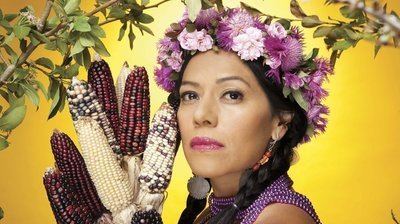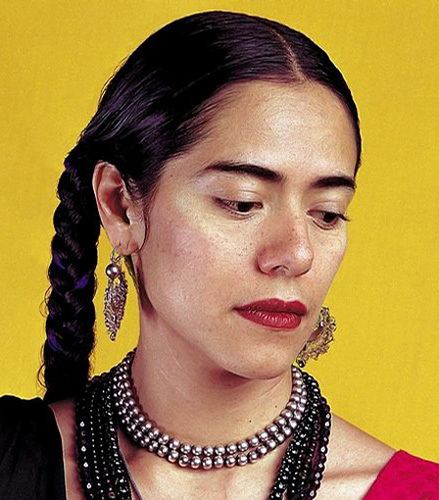Genres World music Name Lila Downs | Instruments Voice, guitar Spouse Paul Cohen (m. 1990) Years active 1990–present | |
 | ||
Born September 9, 1968 (age 57) ( 1968-09-09 ) Role Singer-songwriter · liladowns.com Movies Frida, Mariachi Gringo, Fados, Deseo Albums Pecados y milagros, Raiz, Balas y Chocolate, La cantina: Entre copa y copa, Una sangre: One Blood Profiles | ||
Birth name Ana Lila Downs Sanchez | ||
Lila downs live at town hall 4 19
Ana Lila Downs Sánchez, best known as Lila Downs (born September 9, 1968 · ) is a Mexican-American singer-songwriter and actress. She performs her own compositions and the works of others in multiple genres, as well as tapping into Mexican traditional and popular music. She also incorporates indigenous Mexican influences and has recorded songs in many indigenous languages such as Mixtec, Zapotec, Mayan, Nahuatl and Purépecha. Born and raised in Oaxaca, she primarily studied at the Institute of Arts by Oaxaca and briefly attended University of Minnesota, before withdrawing to focus on her musical career. She soon began performing in the traditional music scene of Oaxaca City.
Contents
- Lila downs live at town hall 4 19
- title of your video lila downs at tedxoaxacacity
- Biography
- 19941996 First albums
- 19971999 La Sandunga
- 19992000 Tree of LifeYutu Tata
- 20012003 BorderLa Linea
- 20042006 Una SangreOne Blood
- 20062008 La Cantina entre copa y copa
- 20082009 Shake AwayOjo de Culebra
- 2010present Lila Downs y la Misteriosa Pecados y Milagros
- 2017 Saln Lgrimas y Deseo
- 20052006 One Blood Tour
- 20082009 Shake Away Tour
- 2010 Black Magic Woman Tour
- 2011 2014 Pecados y Milagros World Tour
- 2015 present Balas y Chocolate World Tour
- Acting
- Soundtracks
- Personal life
- Social activism
- Contributions
- Awards and recognition
- Albums
- DVD
- References

Her first album, Ofrenda, was released in 1994. In 1999, Downs came to prominence with her debut studio album, La Sandunga, which was a critical and commercial success. She achieved international success in 2001 with the album Border which emerged in the music scene of Mexico and Latin America in the early 2000s (decade). Downs's seventh album, Pecados y Milagros (2011), topped album charts in most major markets and generated chart-topping world music albums. Her eighth album, "Balas y Chocolate", was released in 2015. "Salón Lágrimas y Deseo", her ninth album, came out in 2017.

Downs began performing in school, demonstrating her vocal ability with traditional music, Latin and American influences, and with her own original twist on dancing. Downs, a native Spanish speaker, also speaks fluent Mixtec and English. Downs through her activism has gone through great lengths to preserve the Mixtec language as well as many other Indigenous Mexican languages.

Influenced by Chavela Vargas, Mercedes Sosa, Lucha Villa, and Amparo Ochoa, Lila Downs is recognized for her flamboyant, diverse and outré contributions to the music industry through her traditional and authentic fashion, the majority of which are based around Mexico's indigenous peoples' styles, cultures and heritages, which show through her performances and music videos. Her achievements include one Grammy Award and two Latin Grammy Awards.

Besides her musical career, she involves herself with humanitarian causes and political activism, especially dealing with issues of Latin America's indigenous.

title of your video lila downs at tedxoaxacacity
Biography

Lila Downs was born on September 19, 1968 in Tlaxiaco, Oaxaca, Mexico. She is the daughter of Anita Sanchez, a Mixtec cabaret singer and Allen Downs, a British-American professor of art and cinematographer from Minnesota. From an early age Downs showed interest in music. At the age of eight she began singing rancheras and other traditional Mexican songs. She began her professional career singing with mariachis. At fourteen she moved to the United States with her parents. She studied voice in Los Angeles and learned English, which her father helped her to perfect. When she was 16, her father died, and she decided to return to her native Tlaxiaco with her mother.

One day while she was working in a store in the Mixtec mountains a man came in to ask her to translate his son's death certificate. She read that he had drowned trying to cross the border into the United States. This deeply affected her and has continued to influence her work. She talked about this in an NPR interview about her 2001 release entitled Border.
Although today Downs is proud of her origins there was a time when she felt shame regarding her Native American roots. "I was embarrassed to have Indian blood. I was embarrassed that my mother spoke her language in public." This led her on a path to find herself, which included dropping out of college, dying her hair blonde and following the band The Grateful Dead. After some time Downs found herself back in Oaxaca working at her mother's auto parts store, where she met her future husband and musical collaborator, tenor saxophonist Paul Cohen.
Downs studied Anthropology at the University of Minnesota and voice in New York. Later she attended the Institute of Science and Arts of Oaxaca to complete her studies.
At 25, after completing academic and music studies, Downs decided to return to Tlaxiaco. Paul Cohen always encouraged her musical ventures, and she joined a group percussion called Yodoyuxi's Cadets. Because Paul Cohen had business in the United States she began to live in both Minnesota and Oaxaca.
During her stay in Minnesota, Downs formed a group called La Trova Serrana which achieved great popularity among the Latin community within the United States, singing songs about the Zapotec and values and culture. Upon her return to Mexico she started singing in bars, restaurants and clubs in the City of Oaxaca, Philadelphia and California in United States, always with the support of US saxophonist Paul Cohen. She received many positive critical reviews, which led to her decision to undertake an extensive tour of Mexico.
1994–1996: First albums
In 1994 Lila Downs independently made her first album, entitled Ofrenda. This was both a collection of traditional songs from Oaxaca and Mexico, and songs written by the singer with lyrics sung in Spanish, Mixtec and Zapotec (native languages of Oaxaca). The material was produced both independently and with the support of the Oaxacan Cultures Institute. Because this album was not a commercial success in LP or cassette, she never released a version on CD.
In 1996 Downs recorded a live session at a renowned café-bar of the City of Oaxaca. On this record Downs was accompanied by a set of well-known musicians who supported its interpretation of traditional themes, as well as country music and jazz. With this work Downs and her music became known in different parts of the Republic of Mexico, and this was their first album to be released on CD. The album had a big impact, despite limited promotion and the fact that only a small number of copies were made. This CD is now out of print, and although not available as part of the official discography of Lila Downs, can be found in digital format.
1997–1999: La Sandunga
In 1997 Lila Downs made a second recording, called "Traces", on which she performed material that was to be included in later albums such as La Sandunga, Tree of Life and Border. It is an extensive compilation of items in her traditional repertoire but, like its predecessor, had no commercial distribution, so this disc is also currently out of print.
It was not until 1999, when Downs signed with the label Narada Productions, that she achieved commercial success and made herself known internationally with the album La Sandunga. Recorded a year earlier, this material came to the forefront of Mexican music and her album was one of the first to merge the sounds of traditional music and modern rhythms as jazz, blues and bolero. The album was sung in Spanish and mixtec, and was produced by Lila Downs and Paul Cohen with the support of Xquenda Cultural Association. Because of this success, Downs participated in the sound track of the Mexican film Green Stones and achieved great popularity in countries such as Mexico, United States, Spain, France, England and Germany, selling over 500,000 units worldwide.
1999–2000: Tree of Life/Yutu Tata
Downs's next album, Tree of Life, was released in 2000. With this album the fame of Downs continued to spread to other markets in England, Switzerland, Canada and especially the United States. This work found Downs turning to her indigenous past, and the album features pre-Hispanic sounds and instruments. Several of the songs on the album are sung in native Mexican languages such as Mixtec, Zapotec and Nahuatl. In October 2000, she began a two-month tour called the Tree of Life/Árbol de la vida, which included concerts in Latin America, Europe and the US. The tour began in Mexico and ended in Spain.
2001–2003: Border/La Linea
Border, released by EMI Music in 2001, was the first album by Downs to feature songs sung in English. The album was released simultaneously in the United States and Mexico. With this album Downs merged sounds from different genres such as traditional folk music, hip hop, rock and chilena. It included fifteen songs, eleven in Spanish, three in English and one in Mayan. The album received generally good reviews and placed seventh in "Top charts" of world music. It also stirred up controversy due to its frank discussion of immigration, Native American marginalization and the Acteal massacre. This drew criticism, especially from politicians and the church.
The album's first single was released in Mexico, "Mi corazón me recuerda", a poem by Chiapas poet Jaime Sabines. Set to music, it achieved moderate success on the Mexican music charts. In Spain the song "La Llorona", in France the song "Corazoncito Tirano" and in the United States the song "Medley: Pastures of Plenty/This Land Is Your Land/Land" were released as singles. The latter incorporates two Woody Guthrie songs, "Pastures of Plenty" and "This Land is Your Land" as well as original lyrics by Downs in "Land".
2004–2006: Una Sangre/One Blood
One Blood, one of Lila Downs's most successful albums, was released in April 2004, simultaneously in the United States, Spain, and Mexico. The lyrics on this album are about migration, discrimination and the case of Mexican human rights defender Digna Ochoa. In addition to traditional songs such as "La Bamba," "Viborita," and "La Cucaracha," the album includes genres such as son jarocho, jazz, rock and folk. This album contains thirteen tracks, three in English, one in Triqui, one in Purepecha and eight in Spanish. Lyrics were authored by Lila Downs, Paul Cohen, Celso Duarte, and Jose Martí. Lila Downs received in 2005 the Grammy Latino in the category of "Best Album of World Music" for this album and reached the top of the charts in United States, Mexico, Spain, United Kingdom, Germany and France.
2006–2008: La Cantina, entre copa y copa…
Lila Downs took approximately one and a half years to prepare this project, which was released in April 2006. This CD draws on Mexican ranchero songs and merges sounds such as pop, rock, northern, cumbia and hip-hop. This CD contains fifteen tracks, of which twelve are traditional Mexican repertoire authored by Lila Downs, and includes a version in English of "La cumbia del mole", the song that to date is the most well-known work by the artist. "La cumbia del mole" refers to the preparation of Mexican dish and tradition in Oaxaca. This single managed to position itself among the top of the charts in Mexico, United States, Canada and United Kingdom.
In 2007, Downs published a CD with the greatest success in Spanish to date, containing songs from her previous albums La Sandunga, Tree of Life, Border/The Line, One Blood and La Cantina It was entitled simply The Very Best of Lila Downs; was accompanied with a DVD containing thirteen tracks recorded live at a concert in Madrid, Spain.
2008–2009: Shake Away/Ojo de Culebra
Two years after the release of La Cantina, in September 2008 Downs launched Ojo de Culebra in Europe, North America, Australia and Latin America. The album reached sixth place in sales in Mexico, Colombia, Argentina, Spain and several Latin American countries. The first single is titled "Ojo de Culebra" was contributed to by the Spanish singer La Mari by group of flamenco Chambao. The song is a merger of rock cumbia and flamenco with some influences of reggae. This song was at the top of the charts of world music in several countries The second single was "Perro Negro" a merger of rock with ska, (which did not have as much of an international impact as its predecessor,) featured Rubén Albarrán singer of the Mexican rock band Café Tacuba. "Little man" (released in the U.S. alone) and "Justice" were next two singles, the latter with the participation of the Spanish singer Enrique Bunbury. Raul Midon, Gilberto Gutierrez and Mercedes Sosa also contributed to this album.
The single "Black magic woman" achieved moderate success in Europe, United States and Canada, and the single "Silent Thunder" was later well received by the British market. In October 2009 Lila Downs was honored by a plaque at the outskirts of her hometown and birthplace, Tlaxiaco, Mexico, and also was awarded the keys the city for her work preserving the language of Mixtec.
2010–present: Lila Downs y la Misteriosa, Pecados y Milagros
"Lila Downs y la Misteriosa en Paris - Live à FIP" is the second live album by Downs, released on April 13, 2010 in Spain and France, the album was recorded in 2009 in Radio France studio 105 in Paris, France. The album was released in May 2010 in the United States and in July in most other countries. It received positive feedback from critics. Lila Downs y la Misteriosa en Paris was released in Mexico with an edited version of the live concert on DVD and was number one in sales of Gender World Music for the music chain Mixup for three consecutive weeks. Although receiving little promotion the album has received moderate success on the Mexican charts. In a survey of the best albums of 2010 conducted by the Mexican television network Channel 22, this album was ranked number one.
Pecados y Milagros (Sins and Miracles) was the seventh studio album by Mexican singer-songwriter Lila Downs, released on October 18, 2011. The album cover was released on September 14, 2011.
The album debuted at number fifty two on the Billboard 200 becoming her fourth-highest peak on the chart. It also debuted at number one on the Billboard Top Latin Albums Chart and stayed there for over 3 consecutive weeks. This album has sold over 60.000 copies in the US and over 290.000 copies worldwide. The album was recorded in the Mexico City, and New York. Downs describes the album musically as having "a strong rock side" along with "traditional" and "Latino" songs. Celso Duarte is one of several collaborators to appear on the album, featuring on the first single "Palomo del comalito".
Other collaborations include songs with rappers Illya Kuryaki and the Valderramas, Celso Piña and Totó la Momposina. Downs ahas been touring through February 2017 in Mexico, the US and around the world, the Sins and Miracles Tour, which started in Mexico.
Audience members at a concert of February 18, 2012 at New York City El Museo del Barrio were informed that the concert was being recorded by HBO.
In 2015, Lila Downs joined the judging panel for The 14th Annual Independent Music Awards and by doing so, helped to assist the careers of upcoming independent artists.
2017: Salón Lágrimas y Deseo
Downs released Salón Lágrimas y Deseo in May 26, 2017, under Sony Latin. Her next international tour starts at the end of March 2017 on the West Coast of the US, followed by a series of performances in Mexico, Europe and Latin America.
2005–2006: One Blood Tour
Due to the success of the albums One Blood and Border (2001 and 2004), the One Blood Tour took place and Downs performed 30 international shows on three continents. Countries such as the Philippines, Japan, China, Egypt and Afghanistan were included on the tour, where Downs was well received by the public. In May 2007, Downs published a DVD collection as a document of that tour in a concert in Oaxaca and Mexico City; this DVD contained thirteen live tracks and a documentary as well as special features like interviews, short films by Allen Downs (Lila's father) and videos.
2008–2009: Shake Away Tour
In September 2008 the Ojo de Culebra World Tour started, which took place on four continents, and was the most successful tour for a Mexican artist. In Latin America, Mexico was the country with the highest number of concerts (21 in total), the tour officially ended on October 30, 2009 giving a free concert in the Zocalo of Mexico City, followed by Colombia and Costa Rica, with three concerts each.
Although not part of the tour, Lila Downs appeared in the Live Earth in Germany, where she played three songs, and in late 2008 sang at the Harmony Festival held in California, United States.
2010: Black Magic Woman Tour
In March 2010, Lila Downs announced a world tour Black Magic Woman Tour which began in Buenos Aires, Argentina with three sold out shows. This tour included several countries in America Asia and Europe in many of which attendance records were broken. The tour officially ended on November 17, 2010 in Square Dance by Oaxaca City where she had an audience of approximately seven thousand people.
2011-2014: Pecados y Milagros World Tour
Pecados y Milagros World Tour was Lila Downs' fourth musical tour in support of her seventh studio album, " Pecados y Milagros " . It was announced on October 3, 2011 through the official website of the singer.
2015-present: Balas y Chocolate World Tour
Balas y Chocolate World Tour is Lila Downs's fifth concert tour, and promoted her eighth studio album Balas y Chocolate (Bullets and chocolate (in Spanish).) It began on March 26 in Mexico City at the Plaza Condesa, presenting the repertoire of new music album of the same name tour. Canada in 2015, Spain has toured with great success (Cartagena, Barcelona, Valencia, Madrid etc. ), Paraguay, Chile, Argentina (Mendoza, Buenos Aires, Cordoba ), Bolivia, Ecuador, United States ( more than 20 cities, including New York City, Miami, Hollywood, Los Angeles, Step etc.) In 2016 she will be in London, Spain, Argentina and Peru . In August 2016, Lila Downs performed at the 21st Annual Santa Barbara Mariachi Festival alongside Aida Cuevas, Mariachi Sol de Mexico, Mariachi Nuevo Tecalitlan, and Mariachi Reyna de Los Angeles in Santa Barbara, CA.
Acting
Downs has had small parts in such films as Frida, Fados and Hasta el último trago corazón; the latter is a documentary on Mexican music involving various exponents of the genre. Downs worked on the composition and arrangements for the musical Como agua para chocolate, based on the book by Laura Esquivel, which premiered at the Public Theater of New York and Broadway in late 2011 and early 2012. She participated in the filming of the U.S. film Mariachi Gringo directed by Tom Gustafson, where she worked alongside Mexican actresses Adriana Barraza, Martha Higareda and Canadian actor Shawn Ashmore. The film was released in 2012.
Soundtracks
In 2001, Downs was invited to participate in the soundtrack of the Mexican film Piedras Verdes where she performed "Cancion mixteca", in 2002 she participated in the soundtrack for the film Frida singing the song "Burn It Blue" which was nominated in the 75th Academy Awards in the category of Best Original Song. In 2005 she participated in the soundtrack for the film The Three Burials of Melquiades Estrada with the song "Dónde estás papá". Downs has also participated in other soundtracks for films such as Real Women Have Curves and Tortilla Soup. In the film by Carlos Saura, Fados (2007), she sings an unforgettable version of "Foi na Travessa da Palha" in Portuguese.
Personal life
Since the beginning of her career she has been involved with Paul Cohen who is her partner and artistic director. There has been much speculation in the media about the couple's personal life and that the couple could not have children. She talked about some of these aspects of her life in NPR Interviews: Lila Downs Woos Fans with 'Shake Away' and Lila Downs' Cross-Border Musical Influences.
In June 2010, Downs announced on her web site that, after several years of trying to be parents, she and Paul Cohen had adopted a child, Benito Dxuladi. They currently reside in Coyoacán in Mexico City and Oaxaca although most of the time they spend traveling.
Social activism
Downs has been a social activist throughout her entire career and works to maintain her cultural identity in the eye of social distress. For example, she sings with passion, and admiration for her home in Oaxaca, Mexico. Her music draws out many socially significant issues particularly with issues pertaining to the Indigenous, such as the mistreatment and misunderstanding of indigenous peoples of Oaxaca, by celebrating her Mixtec heritage through song. Her albums are socially significant, especially her album, One Blood, or Una Sangre, which includes songs such as "Dignificada," which is a song about Digna Ochoa's assassination. Digna Ochoa was a social activist, and Downs featured her story on her album One Blood.
When asked if she is a politician, Downs said that she does not want to be a politician because she is not interested in power, instead she wants to support and change society through music. On Friday, October 9, 2009 Downs, along with actress Salma Hayek represented Mexico participated in an event for the worldwide campaign of the One Drop foundation, to preserve water. They performed together with the founder of Cirque du Soleil, Shakira, U2, former Vice President Al Gore and other "world-class" personalities.
Contributions
Awards and recognition
Throughout her career Downs has received several awards, including a Grammy, a number of Latin Grammys and Lunas del Auditorio. She has recently unveiled her star on the Walk of Fame located in the outskirts of Auditorio Nacional in Mexico City for her career. Her last album 'Balas Y Chocolate' was listed on i-Tunes as one of the years best in World Music 2015, was one of the UK Sunday Times best albums of the year and was a Best Album of the Year pick in Songlines Magazine, where she was featured on the cover of the June 2016 issue. Some of her most successful songs include: "Tengo miedo de quererte", "Estrella oscura", "La línea", "La llorona", "La cumbia del mole" y "Ojo de culebra".
